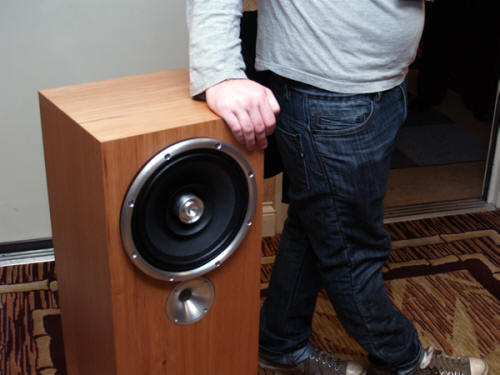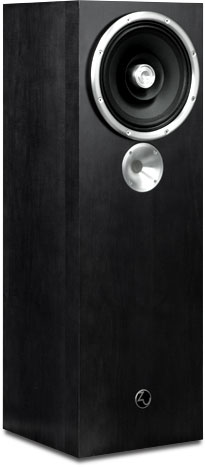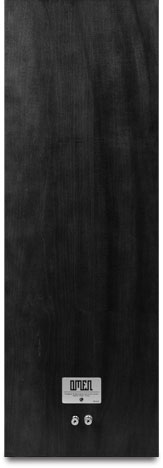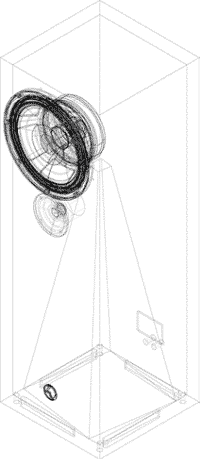|
|
You are reading the older HTML site
Positive Feedback ISSUE 66
zu audio Omen "Dirty Weekend" Edition Loudspeakers - Magnificent Sound for Less Than a Grand! as reviewed by Tom Gibbs
My first set of real loudspeakers were a pair of large cabinet Sansuis, the ones with about a dozen drivers and an 18-inch woofer, with immaculately finished walnut cabinets and Asian-inspired, heavily sculpted walnut grills. If good looks were the sole judge of high quality audio reproduction, those babies were a ten-out-of-ten—they totally knocked it out of the park based on looks alone. The WAF was off-the-charts good—even my mom loved the way they looked! As I recall, I paid around $400 for them in 1975 dollars—clearly the worst money I ever spent over the entire duration of my existence as an audiophile, because they sounded like absolute crap! I just couldn't reconcile within my brain how speakers that looked so friggin' amazingly good could sound so horrifyingly bad. They possessed an almost flat, lifeless midrange and tizzy treble with virtually zero low bass—how could a speaker with a freakin' 18-inch woofer cone have absolutely no bass? I kept them about six months, which amounted to possibly the steepest early learning curve I'd undergone within this hobby/addiction of ours; Lesson One: Good Looks Do Not Always Equate To Superb Acoustic Performance. Now, to be perfectly honest—in retrospect—I still regret getting rid of them, because they were so darn cool looking. I could easily see them in a second system situation somewhere, maybe with updated drivers and heavily modified crossovers – I think the appearance wow factor would still apply in this day and age. I traded the Sansuis towards a pair of ESS AMT 1B's—easily one of the smartest audio moves I've ever made. Although ESS was historically fraught with bass-driver problems, they were also cutting edge with the earliest implementation of the Heil Air Motion Transformer—one hell of an amazing mid-and-high frequency transducer that produced phenomenally liquid sound with amazing soundstaging. Unfortunately, the woofer cones were a poor match for the remarkably fast Heil drivers, but at least I trusted my ears this time around, not only my eyes. I kept them a couple of years, and I also regret getting rid of them—I heard a couple of loudspeakers that utilize the Heil AMTs at the recent AXPONA show in Chicago, and they were just as remarkable in their presentation as I remember them from thirty years ago. I can't exactly remember why I got rid of the AMT 1B's; I think it had something to do with a short-lived personal relationship that went rather badly, and for some reason, they had to go. I basically was speakerless for a year of so, and had become involved at that point with Beth, the woman who would eventually become my wife. I'd heard about these Magneplanar speakers, and Beth and I drove to Atlanta to hear a pair—a life-changing experience for me. When I announced I was working a second job to fund an entry-level pair of MG I-IMP's, she scoffed, certain that the $800 I earned over the next 9 months was going to purchase a diamond engagement ring for her. That was a truly steep learning curve for her, as well—when I pulled up one morning with the unwieldy Magneplanar boxes in tow, she learned a whole lot about me and my priorities. I guess I must have had some other endearing qualities (though God only knows what), since she's somehow managed to hang around for the last 30-plus years. Anyhow, over those same three decades, I owned at least five different incarnations of Magneplanars, and up until about a year ago, pretty much considered myself a totally planar-magnetic kind of guy. With the onset of Beth's cancer in 2002, I went through some pretty serious system paring-down and restructuring during the early 2000's, eventually settling on a used ten-year-old pair of MMGs that I heavily modified with custom built stands and outboard crossovers. Seriously good audio nirvana ensued over the next several years, especially heading into the computer audio age. Despite my long-term love affair with Magneplanars, there were always areas that left me longing for more. Sure, the liquid midrange and treble, and uncanny imaging abilities were always superb, but, wouldn't it also be nice to have truly deep bass and high-SPL dynamic range? I played about with crossovers and subs, which pretty much left me cold—the MMGs just didn't sound quite as seamless unless powered full-range, and any crossover solution that might actually sound good was definitely out of my price range. At this point, my exploration of computer-based audio was full-on, and I was rediscovering so many rock and orchestral titles from my collection that just screamed to be heard at something approaching maximum SPLs—maybe, in this modern age, where my ears are much more well-informed than they were 35 years ago—maybe now was the time to again try an efficient, capable dynamically based loudspeaker system.
Enter Zu Audo When I first started looking around at loudspeakers, I had a handful of criteria that any contenders definitely needed to conform to, most of all, price—the absolute limit was no more than a thousand bucks. And within that rather strict price point, I was truly hoping for the following: 1) Absolutely built like a tank; 2) a well-conceived crossover design; 3) capable of at least 100+ dB acoustic output with total clarity and no signs of mechanical or acoustical strain; and, if possible, 4) seriously good looks. Of course, I consulted the archives of PFO right out-of-the-gate, and came across glowing, off-the-charts reviews from both Danny Kaey and Dean Seislove for speakers from a manufacturer I was totally unfamiliar with: Zu Audio, based in Ogden, Utah. Those reviews were for much higher-end loudspeakers than I was able to budget for, but a quick trip to Zu's website (www.zuaudio.com) showed a wide range of models, and one in particular—the Omen—that at $1500 was much closer to my target price point. A closer inspection revealed a really tempting offer from Zu Audio; they call it the "Dirty Weekend," and it's totally designed for the prospective buyer where this might be their "first time at the rodeo" so to speak. It allows you to buy a pair of Zu Omens with drivers that have been traded in and repurposed; apparently, Zu does a great deal of upgrade work on many of their models, and then offer driver improvements to customers for a relatively bargain price, while buying back their old drivers. Those drivers are then fully cleaned, tested and inspected and mounted in brand-new Omen cabinets; Zu's full-range drivers all share common architecture, and the drivers that arrive in your "dirty weekend" Omens may have come from a comparatively more expensive speaker. A concept that really appeals to me on a number of levels, not the least being price, which is a ridiculously low $999 USD for the pair! Perfectly good drivers—that were probably perfectly good to begin with, but fell victim to some perfectionist's leanings toward eking out that most minute level of performance enhancement—are then reused to good effect, rather than ending up in a landfill somewhere in Utah. The heavily braced cabinets are available in a variety of stock finishes, and even higher-end custom finishes are also available for additional dinero, of course. I chose the stock Electric Blue Maple finish, which is, if I may say so, staggeringly good looking—we definitely fulfilled the looks criteria! The construction and finish quality of these speakers is immaculate and totally beyond reproach.
Zu utilizes an interesting design approach; Sean Casey (CEO and chief designer with Zu) comes from a background building custom motorcycles, and the concept for the deep bass loading found in many Zu models comes from a process he calls ZuGriewe that was developed from his experience with creating increased air-flow in motorcycle engines. The loudspeakers are most unconventional in construction and appearance; there are no grills—the full range drivers and supertweeters are completely exposed (possibly a problem in households with small children and particularly curious cats). The ZuGriewe bass loading is achieved by the placement of a pyramid-shaped insert within the cabinet, and there are downward facing, finger-sized grooves around the perimeter of the base of the enclosure. The speaker is threaded for either spikes or rounded metal inserts (depending on your floor construction) that lift the speaker slightly to allow the back pressure bass wave from the full-range driver to proceed from the cabinet into the listening room. The 10-inch paper cone main drivers in each speaker are based on 1934 RCA designs by Harry Olson and operate full-range, and—get this—there's no crossover! There's a simple resistor that creates the high-pass for the tweeter that provides just a touch of sparkle to the top end—but the vast majority of the music is totally free of any crossover-induced distortion. The Omen is a 12-ohm, high-efficiency design rated at 97dB/watt, so not only can it be pretty easily driven to high volumes by low-wattage tube and integrated amplifier designs—it can take just about any level of wattage thrown at it in stride. The ZuGriewe system lowers the overall system output into the 30Hz range, but these speakers do not sound bass-shy in any way. Set-up and placement While it's nice to know that these incredibly efficient babies can manage with flea-watt amps, I did all my listening with my usual set up, which includes the excellent Emotiva XPA-2 solid-state amplifier (300 wpc) and my Acurus RL-11 preamplifier. Sources included vinyl via my Rega P-2 turntable with its Ortofon 2M Blue cartridge, and SACD playback courtesy of Sony. But seriously folks, most of my listening was done with 16/24/44.1 and 24/96 files ripped to my computer and played back via the High Resolution Technologies Music Streamer II+, and of late, with the newly released HRT Music Streamer HD (like, wow!—another incredible product, and under $500—review also currently in process). I also just this past week added the excellent MG Audio Planus II ribbon speaker cables—which are truly remarkable, by the way—watch for an upcoming review on these very soon! I'm also running two subwoofers in combination with the Omens; a Definitive Technology Powerfield 1500 and a REL T1. The Omens are running full-range, and the low pass for the subs is set at 40Hz, with the output levels set relatively low such that they only add some depth to the very bottom end; you can switch the subs out of the system and there really isn't a significant overall lowering of bass output. The Omens generate tons of bass on their own, but then again, the subs are still great to have with full-blown orchestral or really rockin' music choices. Freed from the usual restrictive placement options of planar type speakers, with the Omens, I started out with something roughly resembling the classic Cardas "Golden Triangle" setup. Eventually over the course of a few months I ended up with them about six feet into the room from the rear wall and with the centers about nine feet apart; the listening position was pretty much an equilateral triangle from the acoustic centers. They don't seem to be really sensitive to sidewall reflections, so I ended up spacing them a bit more widely than the norm, which casts an incredibly broad and deep soundstage. I typically use solo piano recordings that I'm intimately familiar with for placement and set-up; I find that if you can get the acoustic image of a grand piano correctly positioned in the soundfield, a whole lot of other characteristics snap right into place. You can slowly inch the speaker width apart until the image of the piano seems large and deep, but doesn't seem too exaggerated or overly wide. While there's definitely a defined sweet-spot, it's much wider than what I'm used to with the MMGs, and the Omens sound great in both near-field and more deeply placed listening positions. Even considerably off-axis, the listener still gets a lot of information from both channels. Judicious experimentation with room treatments is highly recommended; I think the Omens respond really well to a live-end/dead-end room scenario. Listening results One of the great things about the whole music server scenario is that it greatly enhances your ability to easily access a broad range of music quickly from your listening chair, and I find myself listening to a lot of older music that had long sat dormant on the shelf. A really good example is Talk Talk's mid eighties classic, The Colour of Spring; played from an uncompressed FLAC ripped from the CD, the opening track, "Happiness Is Easy," features an extended kick drum intro that is followed by an acoustic walking bass line that really shows off the Omen's abilities to deal with strong transients. The kick drum is just short of gut-wrenching in impact, but rather than a one-note representation, is not only deep but very dimensionally layered in the tonal palette. You feel the drum, but you can close your eyes and see it as well. The same is true with the acoustic bass line—it's so impressively well-recorded and reproduced, it sounds like something from a jazz album rather than eighties rock. If you haven't heard this album, get a copy—those guys went from riding the crest of the New Wave to playing some of the most challenging but accessibly tuneful music to be heard in that decade. While the music spans a pretty broad range stylistically, some of the songs just demand to be played back loudly, and their presentation doesn't disappoint at all via the Omens. I'd seen various pronouncements online regarding the rather "limited" repertory these speakers were capable of, and don't even think about trying to play anything remotely resembling chamber music or stringed instruments. Obviously those guys didn't spend a significant amount of time with these versatile speakers, or perhaps they were trying to power them with poorly-matched amplifiers—I thought my love affair with the Emotiva XPA-2 was in full bloom after two years, but it truly only began when the Zu Omens showed up! I've thrown a ton of truly demanding classical and chamber music at these speakers, and to this point, they've responded with nothing less than beauty and muscular grace. A great example is the 1973 Columbia recording of Aaron Copland's original orchestration of Appalachian Spring conducted by the composer. The recording was made in Columbia's legendary Thirtieth Street studios in New York City, and is truly one of the gems in Columbia's classical catalog from that period, even though it hasn't fared particularly well (in my humble opinion) in the digital age. Listening to an uncompressed FLAC ripped from the standard issue Red Book CD played back through the HRT Music Streamer HD, and with the Planus II speaker cables in place, I was absolutely transfixed by the sound coming from the Omens—I didn't budge from my chair for the entire performance! While the music on this disc is much more delicate in its chamber presentation of the original ballet score than the usual orchestral versions, it's still quite demanding in terms of dynamics, which the Omens reproduce without strain. But the thing that really got me was how well they resolved the intricacies of this most delicate music. Transfixed is probably a poor choice of words describing my reaction; gobsmacked is probably much closer to the heart of the matter! While I love jazz, classical, folk and all forms of acoustic music, I also love the power of rock music. I've had this ongoing love affair with Rage Against The Machine of late, and while lead singer Zach de la Rocha's vocal screamings might not be everyone's cup of tea, they suit my temperament just fine, both musically and politically. And despite the fact that this music is both loud and brash, at least the drums are still acoustic in nature; the opening track of their sophomore album, Evil Empire, "People of the Sun," (another uncompressed FLAC ripped from the CD) unleashes a flurry of drumbeats that will absolutely shake your home's foundation when played back at reference levels. The rest of the album follows suit, but this is a record that demands to be played LOUD, and the Omens don't disappoint in their ability to present this demanding music with unrestricted dynamics at any volume level. I could go on and on here, almost ad nauseam. I've spent so much time playing and just flat out digging the music, it's been really hard to get focused on writing the review. Do the Omens offer the last word in bass extension and treble clarity? Probably not, but the things that they do well, they do really, really well. They absolutely nail voices and the uber-critical midrange, even with digital sources of questionable origin. They can totally rock hard with the best of them, but also have no problems reproducing the intricacies of massed strings or orchestral music. I have a handful of recordings that I call "train wrecks" that contain passages that—for whatever reason—are particularly difficult to reproduce, including selections from artists as diverse as Rickie Lee Jones and John Coltrane; at this point, I haven't been able to find one track that the Omens haven't just sailed through, and effortlessly. In Conclusion Realistically, I thought my list of wants was pretty extreme at the $1000 price point; I'd probably have been happy to get decent speakers that imaged well and had decent dynamic performance. I'd heard via the internet that the Omens were basically one-note "party" speakers—yes, they'd play loudly, but not with the kind of refinement I was looking for, and that the sound would harden and become more congested if pushed too hard with too many watts. To my happiness and ultimate surprise, I got it all—these speakers are overbuilt (to say the least), are beautiful to look at and play with power and finesse. And never at any loudness level does the soundfield collapse or do they show any signs of strain. Building a carefully matched system is definitely a concern here, but this is a whole lotta speaker for just under a thousand bucks! Yes, these speakers will light up any party, but ohhhh—they're so much more. Having just come from the recent AXPONA high-end show in Chicago, I saw a number of reference and mega-buck systems on display, but carefully matched to the right amplifier and with good sources, these beauties would not be embarrassed alongside any of them. Very highly recommended! Tom Gibbs
Omen
"Dirty Weekend" Edition
Zu
Audio
|











